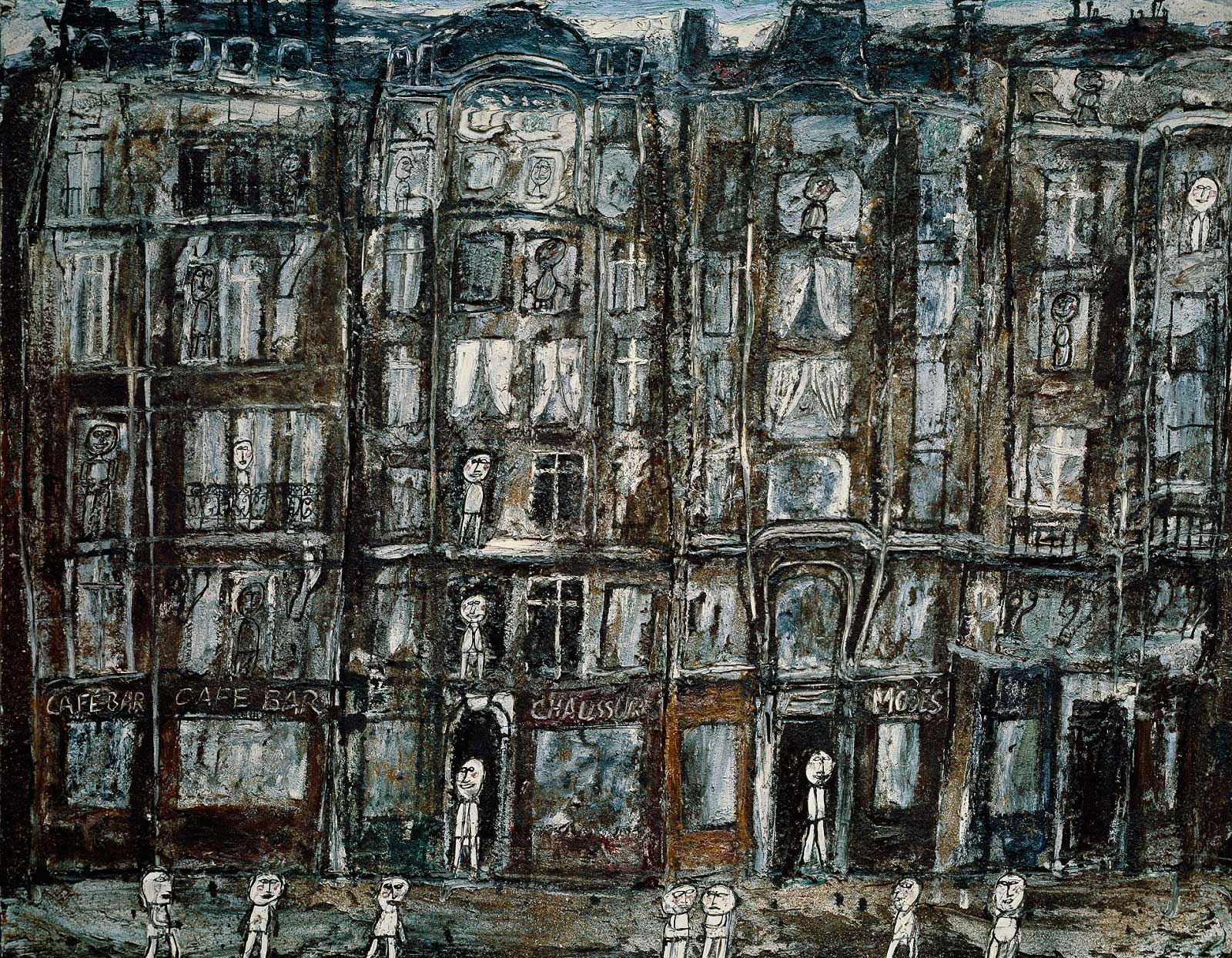Apartment Houses, Paris

Dubuffet scandalised post-World War 2 Parisians the moment they set eyes on his paintings.
After the trauma of Nazi occupation, they were seeking something uplifting and congenial in their galleries, with a redemptive, calm quality.
Instead, Dubuffet (1901- 1985) ignored the prevailing mood and confronted viewers with crude, rough-looking pictures, carelessly drawn, satirically mocking any concepts of thoughtful, profound art.
The pubic wanted beauty – he gave them drab colours, on coarse fabric.
To emphasise their slipshod appearance, they appeared to be painted in an amateurish, infantile manner. Critics were as horrified as the public, and considered the works unpleasant and dirty-looking, likening them to excrement.
This was Dubuffet introducing the world to his creation of Art Brut, raw art.
It was his way of indicating the belief that after the horrors of the war, mankind needed to acknowledge its failings. His pictures graphically made it clear that everything must get back to its roots, building again from the ground up – literally from the soil and rubble of the ‘apocalyptic scorched remains’.
This new movement grew out of Dubuffet’s attraction to outsider artists, and to the drawings of the mentally infirm, as well as the paintings and doodles of children.
He was particularly drawn to their immediacy and vitality of expression, something he found missing in more self-conscious academic art. The directness and texture of Dubuffet’s paintings demonstrated his insistence on the real, echoed by their materiality, and thickly textured, gritty surfaces.
Using tar, sand, cinders, ashes and coal dust, bound with varnish and glue to form a heavy impasto, he would obsessively incise simplistic images onto what would become his much-maligned pictures.
In Apartment Houses, Paris from 1946 Dubuffet forces viewers to confront the reality of urban life, far from the superficial gaiety that Parisian society was desperately trying to project.
Painted with sand and charcoal on canvas, homes are stacked in rows on top of one another, without any attempt at perspective or depth. His childlike rendering of a flattened sky, and the street’s inhabitants, add to the sense of unease, ridiculing the routine sentimental images of Paris and their forced jollity.
Dubuffet was well-educated, although his time studying art at the Paris Académie in 1918 was far from harmonious. He provocatively rebelled against art being categorised – Surrealist, Futurist, Supremacist – and found himself feeling alienated from his intellectually-dry tutors, sensing that he was thought of as a country bumpkin in their eyes, even considered simply a savage.
Dubuffet moved back to his parents’ small country vineyard, and studied on his own, mainly focusing on a simple life of reading and poetry. He didn’t commit himself fully to painting until 1942. His countryside influences are wonderfully evoked in his oddly-titled 1954 picture The Cow With The Subtile Nose.
The painting retains the unschooled, childlike qualities of his immediate post-war art, totally alien to concepts of sophisticated painting.
Again, his thickly textured enamelled surface, and the graphic simplicity of the image of a cow in full profile, filling the entirety of the canvas, was unlike any art seen before, except perhaps in a kindergarten. It is certainly amongst the most singular masterpieces of the Art Brut era.
Jean Dubuffet Overview Continues Below
Frustrated by intellectual approaches to art, Dubuffet continued to admire the artwork of asylum inmates and children. In attempting to recreate what he saw as their uninhibited style, he chose to paint in seclusion, where he could experiment with new methods and concepts, unfettered by fashionable theory or popular trends.
As he explained, ‘The more banal a thing may be, the better it suits me. Luckily I do not consider myself exceptional in any way. In my paintings, I wish to recover the vision of an average and ordinary man’.
‘By Art Brut, I mean pieces of work executed by people untouched by artistic culture. Therefore mimicry, contrary to what happens in intellectuals, plays little or no part. In the work of this group of artists I refer to everything, subjects, choice of materials employed, means of transposition, rhythms, ways of writing, from their own depths and not from clichés of classical art, or art that is fashionable.’
Dubuffet assembled a remarkable and comprehensive collection of Art Brut, which he donated to the city of Lausanne in 1971. It included 5,000 works by 133 artists, gathered in a specialised museum that opened five years later.
Thanks to his dealer, Pierre Matisse, the artist’s son, and the highly influential art critic Clement Greenberg, Dubuffet quickly developed a reputation in America. This was despite the fact that, at that time, American artists were usurping Europeans as New York increasingly became the center of the art world.
Greenberg, the great champion of Abstract Expressionists like Pollock and de Kooning, wrote about him as ‘the brightest new hope of the School of Paris since Miró.’ In no small way this ensured that Dubuffet would regularly exhibit in America, with many of his finest works being acquired by US museums.
Later in his career in 1962, while he was on the telephone, Dubuffet started doodling with a ballpoint pen. He was transfixed by the interlocking forms he had casually drawn, and for the rest of his life restricted himself to the biro colours of red, blue and black.
This stripped-back palette was to become the dominating feature of his vast body of works known as Hourloupes; the shapes within the paintings could be seen as entirely abstract, or read as human or animal forms. ‘This cycle of work was characterised by a much more seriously arbitrary and irrational mood than anything I had done before,’ Dubuffet revealed.
In later years he also created greatly admired sculptural works, with an entirely revolutionary approach – black and white painted fiberglass, in widely differing scales.
They are now part of cityscapes across the world, including Paris, where Dubuffet is now seen as France’s most prominent artist of the last 80 years.
